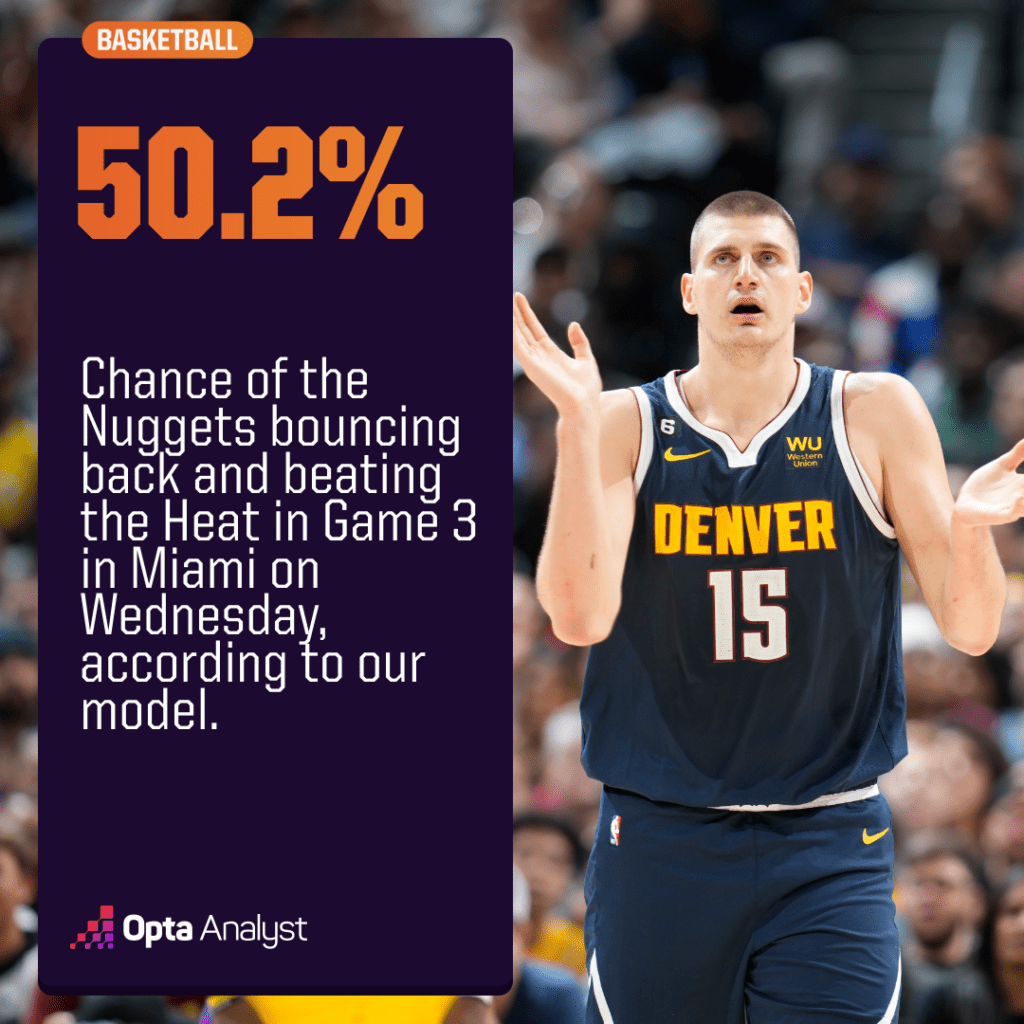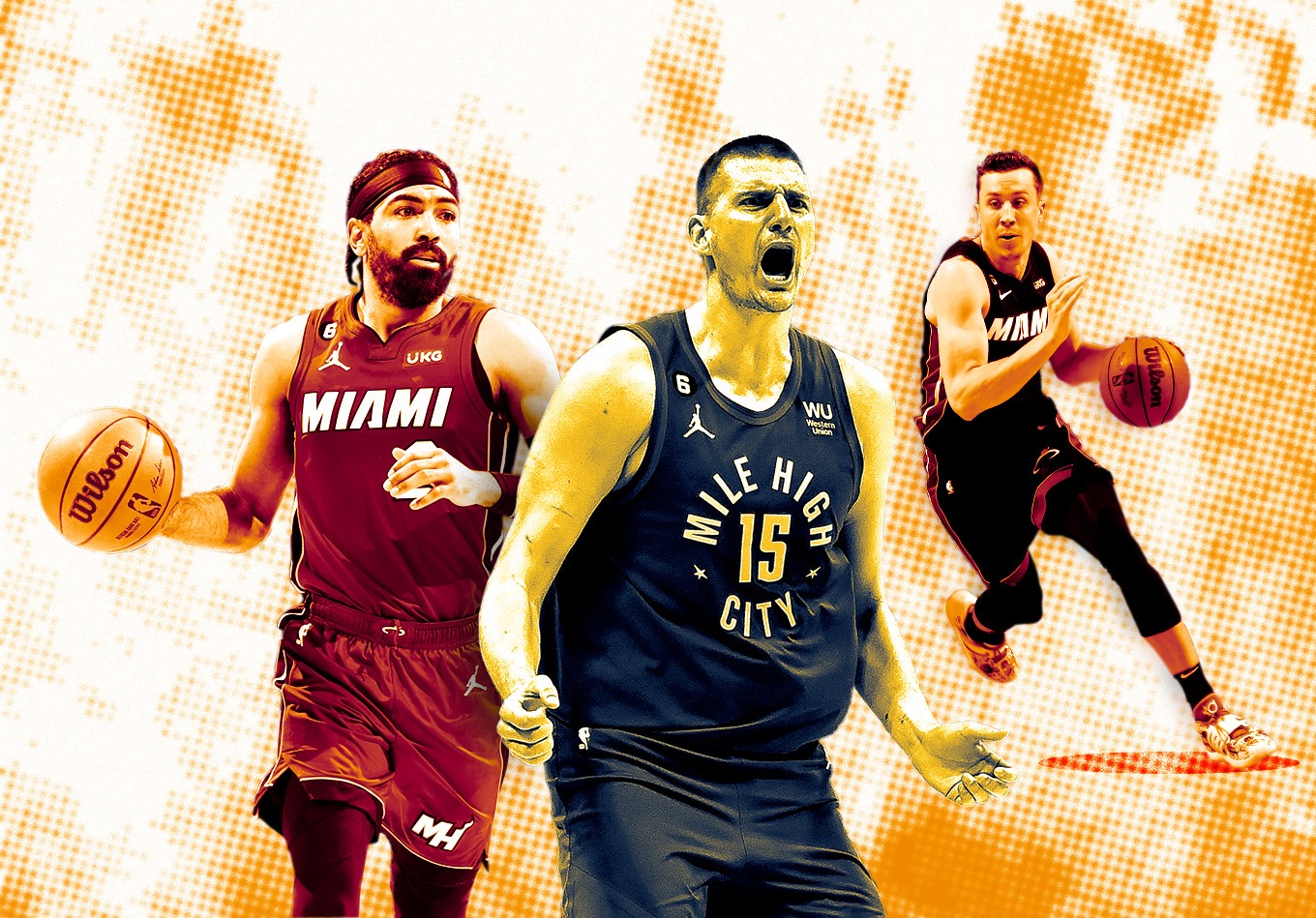And just like that, we have ourselves a series.
After the Denver Nuggets slayed the Cinderella Miami Heat in Game 1, we identified three massive factors that propelled them to victory.
We examined Denver’s size advantage, the Nikola Jokić-Jamal Murray two-man game, and how the Nuggets packed the paint on the Heat without any ramifications.
And you know what? Miami returned in Game 2 with a battle plan that included counters to all of these components.
What exactly did the Heat do? And is it something the play-in team turned Eastern Conference champion can use to help pull off another monumental upset in these NBA playoffs?
It Starts With Shooting
If you’ve scrolled through a box score in the last couple of days, you’ve likely seen that the playoff leader in 3-point percentage (the Heat at 39.2%) shot just 33.3% in Game 1 (and only 25.9% through the first three quarters).
In Game 2, the Heat converted on 17 of their 35 3-point attempts (48.6%). This is important for a couple of reasons. First, hitting 3s adds three points to your total on the scoreboard, and to win basketball games, you need to make sure that your end of the scoreboard reads a higher amount than your opponent’s total.
And second, it makes Denver pay for the way it is defending them. The Nuggets don’t have many great paint protectors, so to fortify the interior, they pack the restricted area with as many bodies as they can.
The tradeoff of doing this is by sagging off of off-ball players to help inside, you are leaving yourself vulnerable to 3-pointers. But for this tradeoff to be fully realized, the other team needs to be able to hit those 3s you are conceding.
In Game 1, Miami wasn’t doing that. Game 2, however, was a different story.
Despite Miami ultimately emerging victorious, Denver’s defense still did what it intended to do – protect the paint. After only allowing 38 points in the paint in Game 1, Denver held Miami to 34 in Game 2.
Outside of how Denver started to defend Duncan Robinson in the fourth quarter (where it started treating him like Steph Curry), it never really deviated from it’s paint-packing approach.
So the question now becomes, what happens first: Do the Nuggets flinch (and change their defensive scheme), or does Miami stop making shots?
Beefing up the Frontline
Who knew that all Miami would need to solve its size problem was to insert its gray-bearded veteran forward into the starting lineup?
After not playing at all in Game 1 (or in the final two games of their series against Jayson Tatum, Jaylen Brown and the Boston Celtics), Kevin Love started Game 2 and posted a plus/minus of +18 in 22 minutes of action (the second-best mark on the team after Gabe Vincent’s +22).
Love provided a big body (6-foot-8, 251 pounds) next to Bam Adebayo who could adequately bang with the heavyweight Aaron Gordon (6-8, 235). And as the clips from Sporting News’ Steph Noh above demonstrate, he also enabled Miami to tap into its own variation of the man-spy technique we touched on in the series preview.
Because Gordon is a shaky shooter and Love touts a good bit of size, Love can help off of him and provide backline assistance in the paint. Gordon was able to burn him for this a couple of times with his cutting around the rim, but for the most part, having Love (two steals) out there proved to be an effective defensive strategy (on top of the shooting/spacing he provided on offense).
With that said, Miami’s Game 2 defensive adjustments didn’t just include playing bigger guys on Gordon. The Heat put some tougher guys on him too.
In the fourth quarter, when Miami outscored Denver 36-25, Gordon played nearly 11 minutes while Love didn’t play a single second. What gives?
What gives is that instead of having Love on him in the fourth, Miami opted to gift its professional pitbull Kyle Lowry with the Gordon assignment. Lowry’s burly build and underdog demeanor give him a fighting chance when wrestling with Gordon. Plus, just like Denver is with the paint packing, Miami is gambling that Gordon won’t be able to make them pay for putting the shorter Lowry on him. In Game 2, the Nuggets couldn’t, as Gordon took just one shot after the third quarter (a wide-open 3-pointer).
Will Miami go with this matchup again in Game 3? And if it does, will Gordon be able to punish the hosts for doing so?
The Jokić Rules
As for the two-man tango between Jokić and Murray that has been largely unstoppable this postseason, Miami figured that the best solution to this conundrum was to take one dancer off the board.
One of the downstream effects of putting Love in the starting lineup is it allowed East finals MVP Jimmy Butler to come off of Gordon and onto Murray. This was part of an initiative by Miami to put more size on Murray to disrupt his rhythm.
Along with Butler (6-foot-7, 230 pounds), the Heat stuck Haywood Highsmith (6-7, 220) and Caleb Martin (6-5, 205) on Murray (6-4, 215). This worked wonderfully, as through three quarters, Murray was held to 10 points. And he only ended the game with 18 because of a late fourth-quarter surge (he had 26 points in Game 1).
By making life harder on Murray, the onus fell on Jokić to be more of a scorer (hence, Jokić only tallied four assists after 14 in Game 1), which, in turn, made life harder on him too.
It certainly didn’t help the Nuggets’ big man that Kentavious Caldwell-Pope and Michael Porter Jr. totaled 11 points on 3-of-12 shooting.
But Miami mixed the coverages it showed Jokić all night. The Heat didn’t “let” him be a scorer. However, they did choose to hard double him less and go for more fronting in the post, late help, and of course, some exotic Heat zone sprinkled in there for good measure.
The funny thing about that, though, is that Jokić still had 41 points on 65% true shooting and 11 rebounds. And the Nuggets were still only one Murray 3-pointer away from sending the game into overtime. So, while Miami did enough to slow down Jokić to snag Game 2, Erik Spoelstra’s club is far from figuring out the surefire blueprint to vanquishing the Nuggets.
Moving forward, the Heat need to keep replicating and tweaking this formula and hoping that they can keep willing themselves to more ugly victories like this one. But if they can continue to hit their shots, find ways to remedy the Western Conference champs’ size advantage, and keep throwing different problems at Murray and Jokić, the Heat could become the first eight-seed to win an NBA championship.
Game 3 Win Probability: Who Has the Edge?
Our win probability model calculates each team’s chances of winning (in this case, Wednesday’s Game 3 on ABC) based on thousands of simulations.
It incorporates our adjusted team ratings (including overall adjusted team rating, adjusted offensive rating, and adjusted defensive rating), accounts for recency bias (so it gives more weight to teams playing well), and for how well teams performed against other good teams.

After losing home-court advantage, the model gives the Nuggets just a 50.2% probability of stealing it back and taking a 2-1 series lead in Miami. Not a huge edge for a top-seeded team facing a No. 8 seed, but indicative of how far the Heat have come to this point.
Like this? Follow us on Twitter for more.
